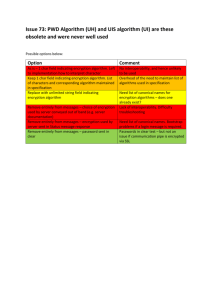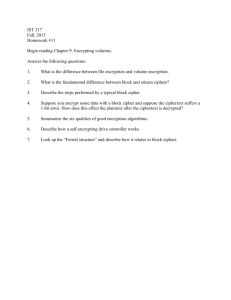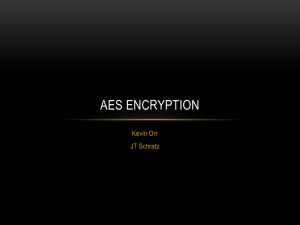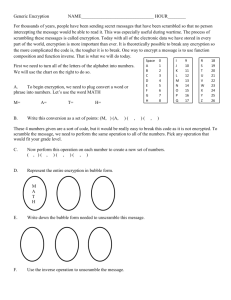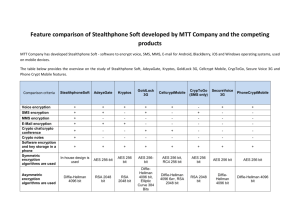15.Image Encryption Based On AES Key Expansion
advertisement
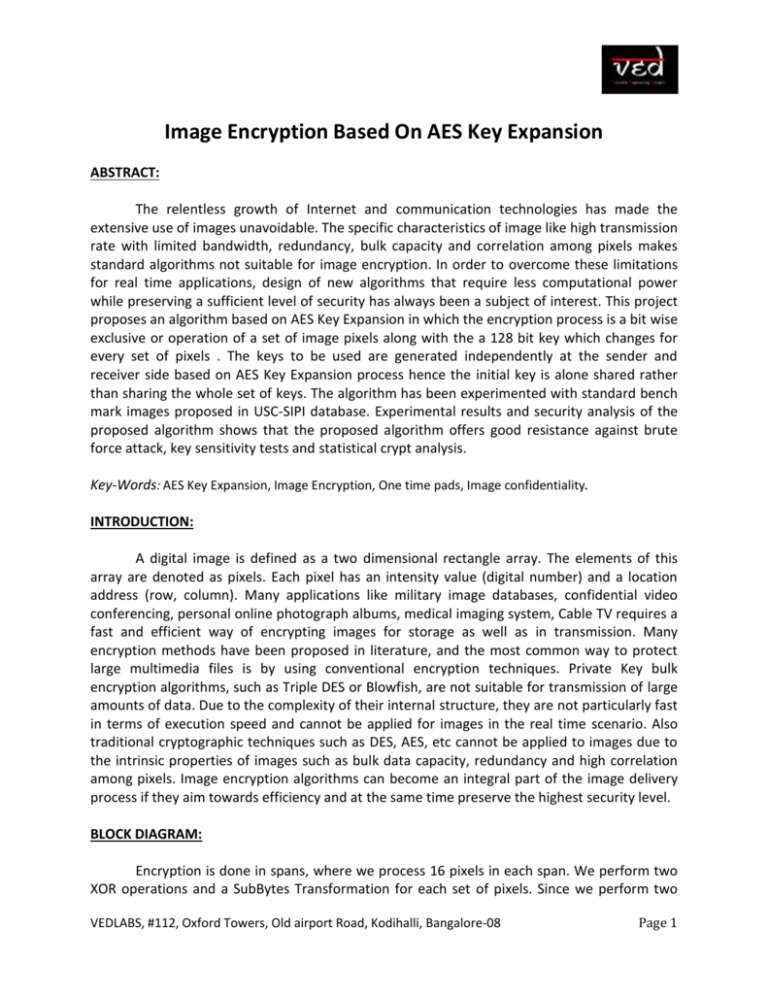
Image Encryption Based On AES Key Expansion ABSTRACT: The relentless growth of Internet and communication technologies has made the extensive use of images unavoidable. The specific characteristics of image like high transmission rate with limited bandwidth, redundancy, bulk capacity and correlation among pixels makes standard algorithms not suitable for image encryption. In order to overcome these limitations for real time applications, design of new algorithms that require less computational power while preserving a sufficient level of security has always been a subject of interest. This project proposes an algorithm based on AES Key Expansion in which the encryption process is a bit wise exclusive or operation of a set of image pixels along with the a 128 bit key which changes for every set of pixels . The keys to be used are generated independently at the sender and receiver side based on AES Key Expansion process hence the initial key is alone shared rather than sharing the whole set of keys. The algorithm has been experimented with standard bench mark images proposed in USC-SIPI database. Experimental results and security analysis of the proposed algorithm shows that the proposed algorithm offers good resistance against brute force attack, key sensitivity tests and statistical crypt analysis. Key-Words: AES Key Expansion, Image Encryption, One time pads, Image confidentiality. INTRODUCTION: A digital image is defined as a two dimensional rectangle array. The elements of this array are denoted as pixels. Each pixel has an intensity value (digital number) and a location address (row, column). Many applications like military image databases, confidential video conferencing, personal online photograph albums, medical imaging system, Cable TV requires a fast and efficient way of encrypting images for storage as well as in transmission. Many encryption methods have been proposed in literature, and the most common way to protect large multimedia files is by using conventional encryption techniques. Private Key bulk encryption algorithms, such as Triple DES or Blowfish, are not suitable for transmission of large amounts of data. Due to the complexity of their internal structure, they are not particularly fast in terms of execution speed and cannot be applied for images in the real time scenario. Also traditional cryptographic techniques such as DES, AES, etc cannot be applied to images due to the intrinsic properties of images such as bulk data capacity, redundancy and high correlation among pixels. Image encryption algorithms can become an integral part of the image delivery process if they aim towards efficiency and at the same time preserve the highest security level. BLOCK DIAGRAM: Encryption is done in spans, where we process 16 pixels in each span. We perform two XOR operations and a SubBytes Transformation for each set of pixels. Since we perform two VEDLABS, #112, Oxford Towers, Old airport Road, Kodihalli, Bangalore-08 Page 1 XOR operations using our expanded key for every set of pixels it is impossible to get the key from plain image and cipher image, and to improve the non linearity we also use the s-box values used in AES. The decryption process is similar as encryption, but we use Inverse SubByte Transformation and also the order of XOR operation using the expanded key is reversed. Figure 1. Block diagram for encryption and decryption process VEDLABS, #112, Oxford Towers, Old airport Road, Kodihalli, Bangalore-08 Page 2 HARDWARE AND SOFTWARE REQUIREMENTS: Software Requirement Specification: Operating System: Windows XP with SP2 Synthesis Tool: Xilinx 12.2. Simulation Tool: Modelsim6.3c. Matlab Hardware Requirement specification: Minimum Intel Pentium IV Processor Primary memory: 2 GB RAM, Spartan III FPGA Xilinx Spartan III FPGA development board JTAG cable, Power supply REFERENCES: [1] C.J.Kuo, Novel image Encryption Technique and its application in progressive transmission. Journal of Electron imaging 24 1993 pp 345-351. [2] N.J.Bourbakis, C.Alexopoulos, Picture data encryption using SCAN patterns. Pattern Recognition 256 1992 pp567 -581. [3] Chin-Chen Chang, Min-Shian Hwang, Tung-Shou Chen, “A new encryption algorithm for image cryptosystems”, The Journal of Systems and Software 58 (2001), 83-91. [4] Fridrich Jiri, Symmetric ciphers based on two dimensional chaotic maps, Int. J. Bifurcat Chaos 8 (1998) (6), pp. 1259– 1284. [5] J. Scharinger, Fast encryption of image data using chaotic Kolmogrov flow, J. Electronic Eng 7 (1998) (2), pp. 318–325. VEDLABS, #112, Oxford Towers, Old airport Road, Kodihalli, Bangalore-08 Page 3
